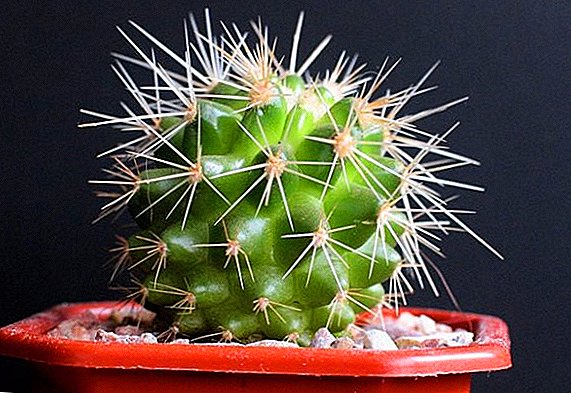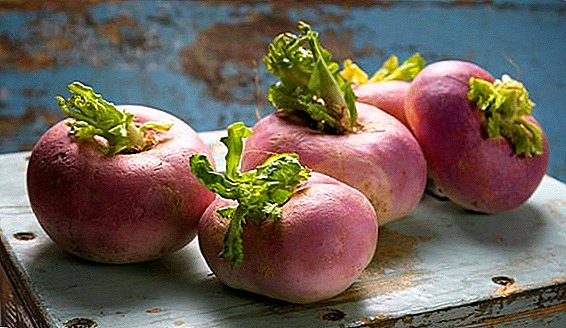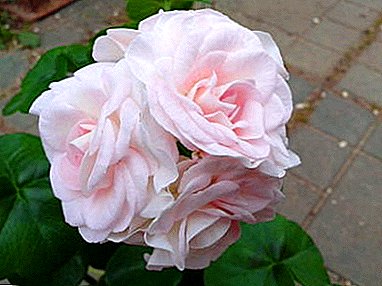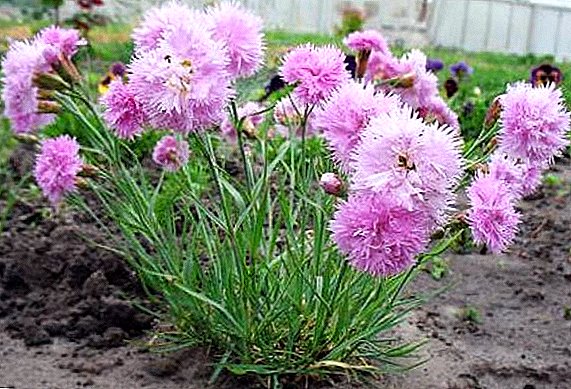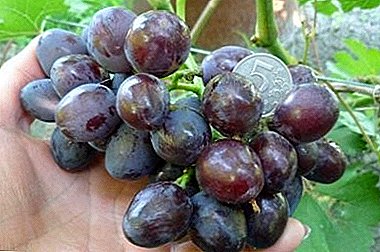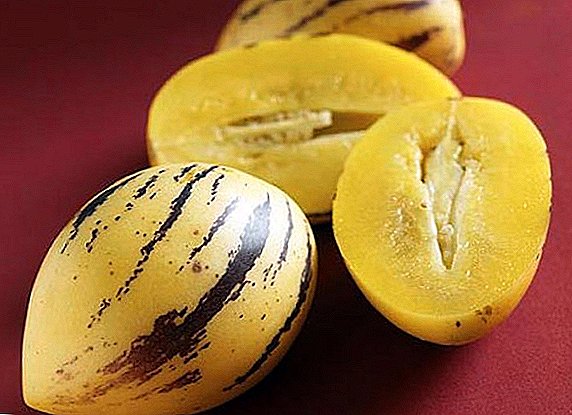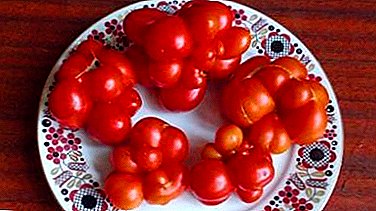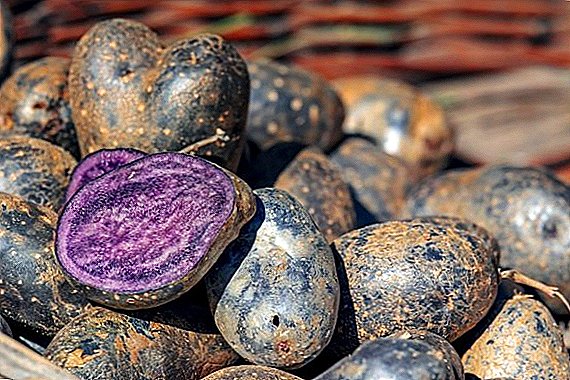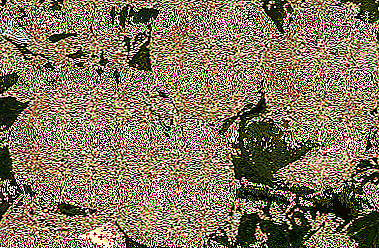
The variety "Krasulya" appeared not so long ago in the garden plots, but it has already gained great popularity. It is impossible not to recognize among other pear trees, thanks to bright elegant fruits with a unique tart taste.
In order to plant, grow and get a good harvest a variety of Krasuli pears, it is important to know all the characteristics of the variety and the requirements for caring for it - a full description of the variety and a photo of the fruit is given later in the article.
What kind is it?
Pear "Krasulya" is summer variety with superearly periods of fruit ripening.
 It ripens about a week earlier than such a variety known for its precociousness as "Severyanka".
It ripens about a week earlier than such a variety known for its precociousness as "Severyanka".
Krasulia is famous for the wonderful taste of fruits and is grown for fresh consumption, as well as the preparation of jam, juice and compotes.
Summer varieties include: Duchess, Chizhovskaya, Moscow Early and Limonka.
Breeding history and breeding region
The variety is the result of breeding work on the cultivation of pears that can successfully bear fruit in the conditions of the Urals. The South Ural Institute for Horticulture and Potato, located in the city of Chelyabinsk, was engaged in this task.
Cross varietiesA small bit of happiness"and"Late", a well-known breeder E. A. Falkenberg received a wonderful" Krasuli "pear, which immediately gained the sympathy of gardeners.
The variety "Krasuli" in 1987 was allocated to elite varieties, and in 2002 it was recommended for cultivation in the Ural region. "Krasulu" can be found not only in the Urals, but also in the gardens of Western Siberia.
In this region, the varieties are doing well: Lada, Lyubovitsa Yakovleva, Children’s and Dessert Rossoshanskaya.
Pear "Krasulya": description of the variety and photos
 Trees have varieties average height and reach no more than 4 meters in height. As the Krone grows, it takes on a rounded and slightly sprawling shape.
Trees have varieties average height and reach no more than 4 meters in height. As the Krone grows, it takes on a rounded and slightly sprawling shape.
Straight branches grow almost at right angles, and their tips are usually directed upwards.
The trunk of the pear is cone-shaped and slightly twisted. The slightly flaky bark on the trunk and main branches is colored greenish.
The leaves are rather broad and rounded with a finely edged margin. The leaf plate is smooth, without pubescence and slightly curved downwards. Only brown shoots and long stalks are covered with leaves.
Flower buds are allocated with rather large sizes and the extended form. Fruiting "Krasuli" mixed type - fruits are formed on short fruit twigs, kolchatka and last year's growth.
Large white flowers of a variety with oval petals are cupped. They exude a very pleasant aroma. Flowering pear "Krasulya" begins in mid-May.
The fruits of "Krasuli" have flattened round shape. Their weight ranges from 90 to 120 g. The fruit has no funnel, but in its place is an unusual shape of growth, which is considered a varietal sign of pear.
Ripe fruits "Krasuli" extremely attractive, so she got its name. The smooth skin of pears is tender, oily and glossy.
Beautiful pears can boast such varieties of pears: Rossoshanskaya Beautiful, Karataevskaya, Kupava and Limonka.
 Its main color is greenish with yellowness, and the covering on the main part of the fruit is red with a slight violet shade. Under the skin can be seen a lot of subcutaneous points.
Its main color is greenish with yellowness, and the covering on the main part of the fruit is red with a slight violet shade. Under the skin can be seen a lot of subcutaneous points.
The creamy flesh of the fruit "Krasuli" is very tender with a loose half-greasy structure. It has a rich sweet and slightly spicy taste with a rich range of shades.
Tasting assessment of the variety on a five-point system - 4.7 points.
Great taste have Ilinka, Cosmic, Chizhovskaya and Fairy.
| Composition | amount |
|---|---|
| Sahara | 11,2% |
| Acids | 0,49% |
reference. Another varietal feature of the Krasulia pear is the presence of thorns inside the crown, which to some extent makes harvesting difficult.
For more information about the variety and see the pears "Krasuli" on the photo below:




Specifications
"Krasulya" glad gardeners with high yields. It begins to bear fruit in the fifth year of life.
From one adult tree "Krasuli" can be collected up to 50 kg of the most delicious harvest. Fruit ripen in early August. After removal, they can be stored in the refrigerator up to two weeks.
Similar yields are demonstrated by the Janvarsky, Chudesnitsa, Samara Beauty and Tatiana varieties.
 "Krasulia" is winter hardy variety. However, young fragile trees can freeze slightly, so it is necessary to warm them for the winter.
"Krasulia" is winter hardy variety. However, young fragile trees can freeze slightly, so it is necessary to warm them for the winter.
As soon as the pear begins to bear fruit, its winter hardiness increases dramatically.
Help - "Krasulya" is a self-infertile varietytherefore, it requires a neighborhood of pollinating varieties. Recommended "Severyanka" and "Rainbow."
Nick, Thumbelina, Lira and Fairy Tale possess good winter hardiness.
Planting and care
- Landing.
For planting should choose seedlings with well-developed roots. Pears can be planted in autumn or spring. The place for the pear is chosen well lit and protected from cold winds. Groundwater at the site should be at a depth of at least 2.5 m from the soil surface.The optimal scheme of planting seedlings of Krasulia pear is 3 by 6 meters. The best soil for a pear is loamy or sandy-black earth. It is desirable that the earth was acidic or slightly acid.
When planting in weakly alkaline soil, it is recommended to add half a kilogram of "long-playing" oxidizer - sulfur. The landing pit is prepared a couple of weeks before work or even earlier, and best of all in the fall, if spring planting is carried out.
Pit sizes: about 1 m deep and no more than 80 cm in diameter. Prepared pit filled with fertile soil.
To do this, the upper layer of earth, about 30-35 cm thick, previously dug out of the pit, is mixed with the following components:

- three buckets of compost or humus
- sand bucket
- 500 ml of potassium chloride
- dolomite flour bucket
- about a liter of ash
- 500 ml of superphosphate
The pit is one-third filled with carefully mixed fertile mixture and left in this form before the start of planting, which are carried out in the following order:
- Before landing, a wooden peg is driven into a hole 30 cm from the center - it should rise 50-60 cm above the ground.
- In the center of the pit, they put a mound, put a seedling on it and gently straighten all the roots on the sides.
- A hole with a seedling is filled with earth, slightly shaking the tree, so that voids do not form between the roots and they all fill with earth. When planting, the root collar should rise 3-6 cm above the soil surface.
- Next, the ground around the seedling is tamped, and the tree itself is tied to a peg.
- In a radius of 30 cm around the trunk make a watering hole and pour into it from 3 to 5 liters of water. Pristvolny circle mulch compost or peat.
Important! On wet soils with close groundwater deposits, a landing pit is not required.
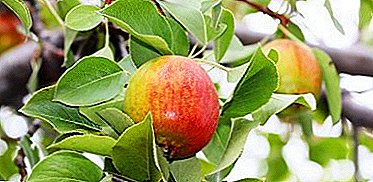 In this case, drainage is made for the outflow of water, and the tree is planted on a hillock built from fertile land.
In this case, drainage is made for the outflow of water, and the tree is planted on a hillock built from fertile land.As with any culture, the Krasulia pear needs careful care, which consists of proper watering, regular loosening, timely pruning and protection from pests and diseases.
- Watering.
Pear requires abundant watering, but should not be carried out too often - enough from 2 to 4 times a month, depending on weather conditions. The irrigation rate is from 2 to 3 buckets per square meter of circle wheel. It is important that the water during watering penetrated 60-80 cm deep.Whether irrigation is needed can be determined by the condition of the soil. To do this, you need to dig a small hole 10 cm deep, take the soil from its bottom in your hand and squeeze. If the earth crumbles in your hand, then it’s time to water the pear.
For pears, it is especially important that the soil be wet before flowering, after it, at the time of formation of the ovaries and after harvesting. Watering should be on the perimeter of the crown of the tree. Watering under the trunk is considered a big mistake.
- Loosening and mulching.
Keeping the stem clean and regularly loosening are important conditions for pear health. It is necessary to remove weeds in time and clean the soil from various debris.To keep the ground under the tree steadily wet, after watering or rain, one should pierce it to a depth of 5 to 6 cm and thrash it with grass, straw or peat.
- Top dressing. Pear trees begin to feed in the second year of life. Organic fertilizers are applied every three years.
Every spring, fertilizing with nitrogen fertilizers is carried out, and in the beginning and middle of summer potash and phosphate fertilizers are applied.
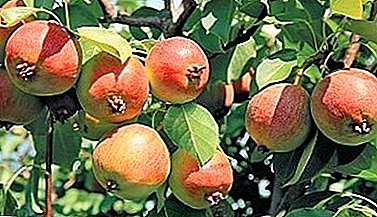 Crop. Immediately after planting the seedlings spend forming pruning.
Crop. Immediately after planting the seedlings spend forming pruning.To stimulate better branching in one-year-olds, all branches are cut to one-third.
In two-year-old saplings, the shoot, competing with the leader, is shortened by two thirds, the other branches by one third.
In the future, pear requires only sanitary pruning. Removed branches growing inside the crown, as well as dry, broken and sore branches.
Experienced gardeners also recommend that in the fall, shorten annual branches with a large increase of half the length, and short ones by one third.
All cuts and cracks in the tree are smeared with garden pitch or a mixture of 2 parts of clay and one part of the mullein with the addition of a small amount of copper sulphate.
- Preparing for the winter.
In a snowless and severe winter, young pears are particularly susceptible to freezing. To protect their sensitive roots, the subcrown zone must be mulched with a thick layer of earth and covered with insulating material.Shtamby young and adult trees should wrap covering material. It is undesirable for this to use film and roofing material, since they do not allow air to pass through. A coniferous spruce tree tied to the tops down, or a special mesh, effectively protects the tree trunk from rodents.
Diseases and pests
 Pear "Krasulya" distinguished by resistance to scab and bacterial cancer, but may be susceptible to other diseases of fruit trees.
Pear "Krasulya" distinguished by resistance to scab and bacterial cancer, but may be susceptible to other diseases of fruit trees.
Mealy dew. For the prevention of the disease in spring, pear trees are sprayed with a solution of colloidal sulfur (two or three treatments at intervals of two weeks).
In case of severe damage, trees are sprayed with chemicals (Skor, Tilt KE, Previkur, Bayleton, Vitaros, Topaz). Trees are needed in the fall Bordeaux liquid.
Fruit Rot most often appears in the rainy season. The flesh of the fruit becomes brown and becomes inedible. All diseased fruits must be removed from the site and destroyed.
For the prevention of the disease in early spring and after flowering, the plants are treated with Bordeaux liquid. In the fall, the plants are sprayed with a saturated solution of urea.
Rust For this disease, Hom, Azofos, Medex, and Strobe are effective. They are sprayed with plants before and after flowering, as well as during fruit set.
Variety "Krasulya" not afraid of pear gall mitebut may be attacked by other pests. The fight against them is carried out with the help of insecticides:
From the leafworm - treatment with karbofos during the swelling of the kidneys and after flowering. Insect larvae can be destroyed using the infusion of tobacco and tobacco (400 g diluted in 10 liters of water and insist for 2 days, drain and half dilute with water).
 From the pear sucker - the first spraying before the start of flowering "Iskra-M", and the second - after it, "Iskra DE". The fouling of trees with tobacco smoke is detrimental to adult suckers.
From the pear sucker - the first spraying before the start of flowering "Iskra-M", and the second - after it, "Iskra DE". The fouling of trees with tobacco smoke is detrimental to adult suckers.
From pear moth - treatment with Iskra bio with Kinmiks or Decis before and immediately after flowering. Approximately one month after flowering, you can additionally spray the Iskra DE trees.
Also effective against moth "Agravertin", "Fitoverm", "Iskra-bio", "Aurum-S". In the spring, trapping belts are set on tree trunks, and bait is used to catch moth moths.
Resistance to diseases is shown by the following varieties: Elena, Svetlyanka, Hera and Cathedral.
Proper and timely tree care helps prevent pests and diseases. It is necessary to conduct pruning with thinning of the crown in time for better ventilation. In autumn, near-trunk circles and aisle need loosening.
The Krasulia pear is an unpretentious, precocious and frost-resistant tree that can beautify any garden. To grow a beautiful pear and get the first harvest, it will take a lot of time and effort. However, the fruits of "Krasuli" are so tasty and attractive that they will pay back all your labors.



 In this case, drainage is made for the outflow of water, and the tree is planted on a hillock built from fertile land.
In this case, drainage is made for the outflow of water, and the tree is planted on a hillock built from fertile land. Crop. Immediately after planting the seedlings spend forming pruning.
Crop. Immediately after planting the seedlings spend forming pruning.